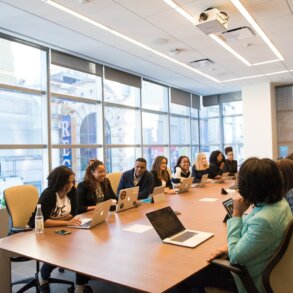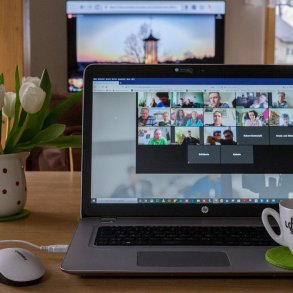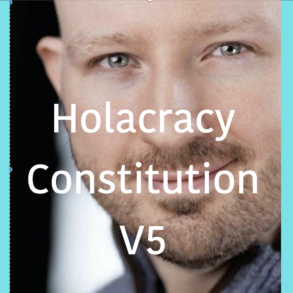By Cecile Green and Rebecca Fisher-McGinty, republished and edited from Round Sky Solutions blog
Enlivening Edge Magazine has republished Part 1 of this article here.
So many of us have experienced bad meetings ranging from mildly frustrating to intolerable! In fact, bad meetings are so common, it’s easy to assume they are an inevitable part of the status quo. If you have a small business, a nonprofit, board meetings, organizing meetings, a worker cooperative, or are interested in democratic or Teal workplaces, you likely have to participate in meetings that drive you nuts for a variety of reasons. If so, you are in the right place, we wrote this post for you! In Part 1, we’re focused on some of the things that come up during these meetings and then part 2, we’ll share some solutions.
We wanted to share with you four hacks out of the dozens that we’ve researched and synthesized into the collaborative operating system called Collab that we teach. These are the top four that we recommend getting started with and hope you give them a try. If you do, please let us know what you think in the comments.
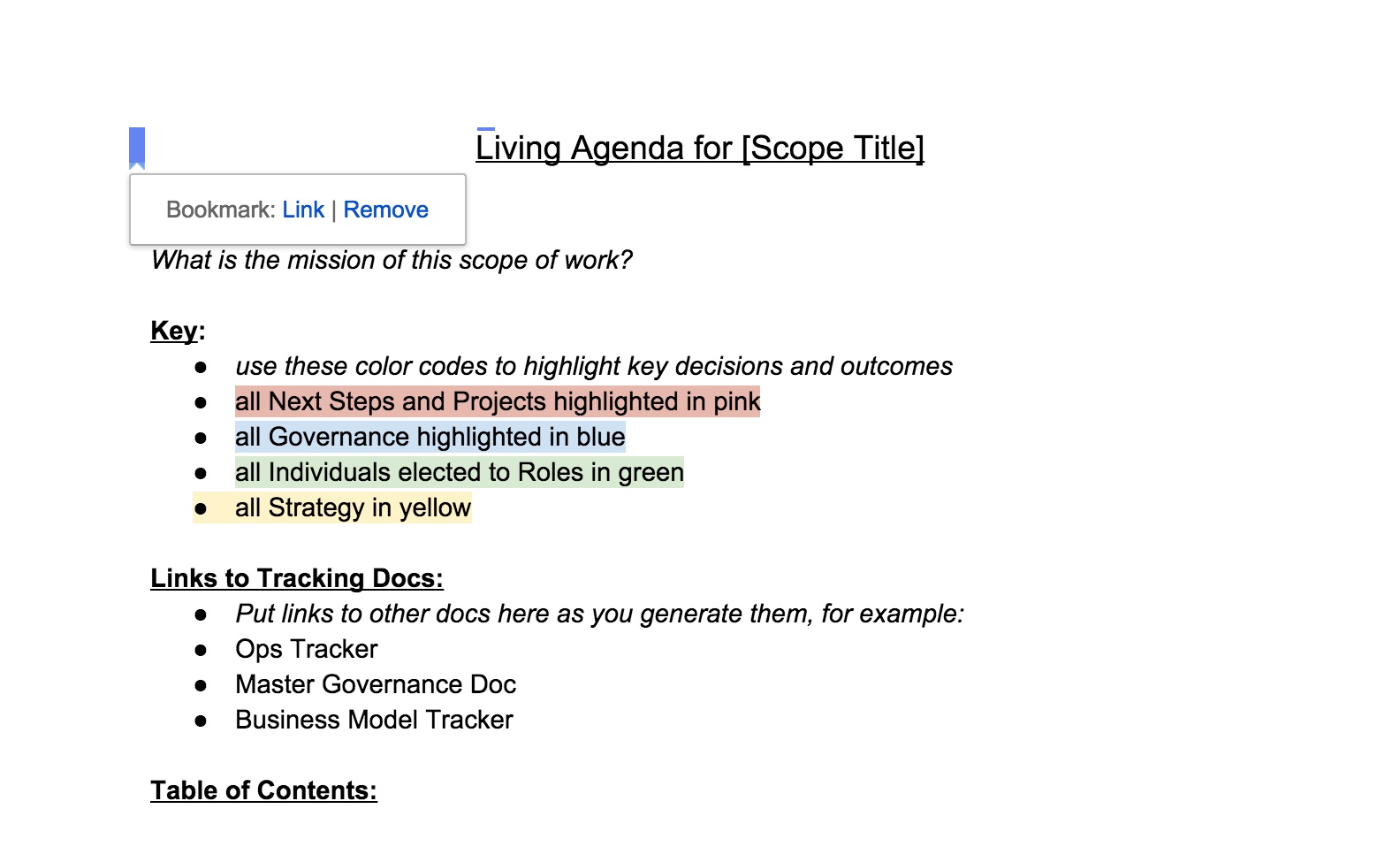 Hack #1: the living agenda
Hack #1: the living agenda
One of the simplest, easiest places to start is what we call the ‘living agenda’. This is a simple google doc, shared with all members of the team, and used as a visual reference during the meetings by all team members. As the name suggests this document becomes a repository of meeting outcomes, with one date stacked upon the next, with the most recent at the top. As a google doc it is searchable and available to all team members in real time.
One of the benefits of a real time visual reference is that we all get to see the outcomes being recorded. This makes it much more clear that we are not moving on from one item to the next until we’ve recorded a clear decision or next action. Those decisions and next actions can be color coded for ease of reference. The use of this simple doc can keep your conversations focused and targeted on outcomes. It also means that one person can’t just derail a conversation that’s underway because the expectation is that we complete one item, including recording outcomes that everyone can see and consent on before we move on to the next.
We’ve developed a template for you to use that you can find here. Feel free to make a copy and use it in your next team meeting. We recommend you use the template for the meeting practice and copy and paste that down for each instance of a meeting, changing the title to reflect the date.
 Hack #2: the standard meeting practice with facilitator and scribe
Hack #2: the standard meeting practice with facilitator and scribe
Another benefit of the Living Agenda is that it offers a template for your meeting practice that standardizes how meetings are held. There’s a LOT of information that goes into each of the steps of what we call the Standard Meeting Practice, which you can learn more about how to effectively facilitate that in our Collaborative Leadership Certification Program, but the key here is having a repeatable process for your meetings that is clear, fair and transparent. This streamlines people’s expectations for meetings making it much easier to participate in a generative way.
In addition, our research and testing has shown that meetings flow much more easily when there’s an elected facilitator whose job it is to take us through the steps of the meeting process, and an elected scribe whose job it is to record the clear outcomes of the agenda items in the living agenda where everyone can see them.
When you elect your facilitator, keep in mind that it’s much better not to have the manager or lead of your team be the facilitator and here’s why: the manager or team lead already usually has a lot of power. So does a facilitator. And combining the two centers of power in one person often results in meetings being skewed to represent that one person’s perspective and desires. This leads to disengagement and lack of incremental improvement outside of that one person’s ideas.
The scribe role is also vital because how information is recorded and therefore remembered is also a locus of power. Having one elected scribe means that we know whose job it is to write on the Living Agenda. Having many scribes in a meeting is an invitation to confusion, argument and frustration. Elect one person as scribe who is in charge of those details, and give them the power to step in and request a clear outcome of an agenda item before moving on to the next, if that’s needed.
 Hack #3: rapid, effective collective decision making
Hack #3: rapid, effective collective decision making
The third hack that we want to share with you is the power of a clear, efficient and effective collaborative decision making process. So many issues can be solved when how we make decisions is clear to everyone, fair so all can participate, and efficient so we can make decisions together rapidly rather than have them drag on interminably. The other benefit to a clear collaborative decision making process is that it distributes power to all members of a team rather than having just one person, often the manager, making all decisions.
So we’d like to offer you the model for collaborative decision making that we use called Integrative Consent. Here’s a link to our resources page where you can sign up for a flowchart for Integrative Consent. We hope you give it a try! One of the secret ingredients in making Integrative Consent work well is what we’re going to share in our next hack.
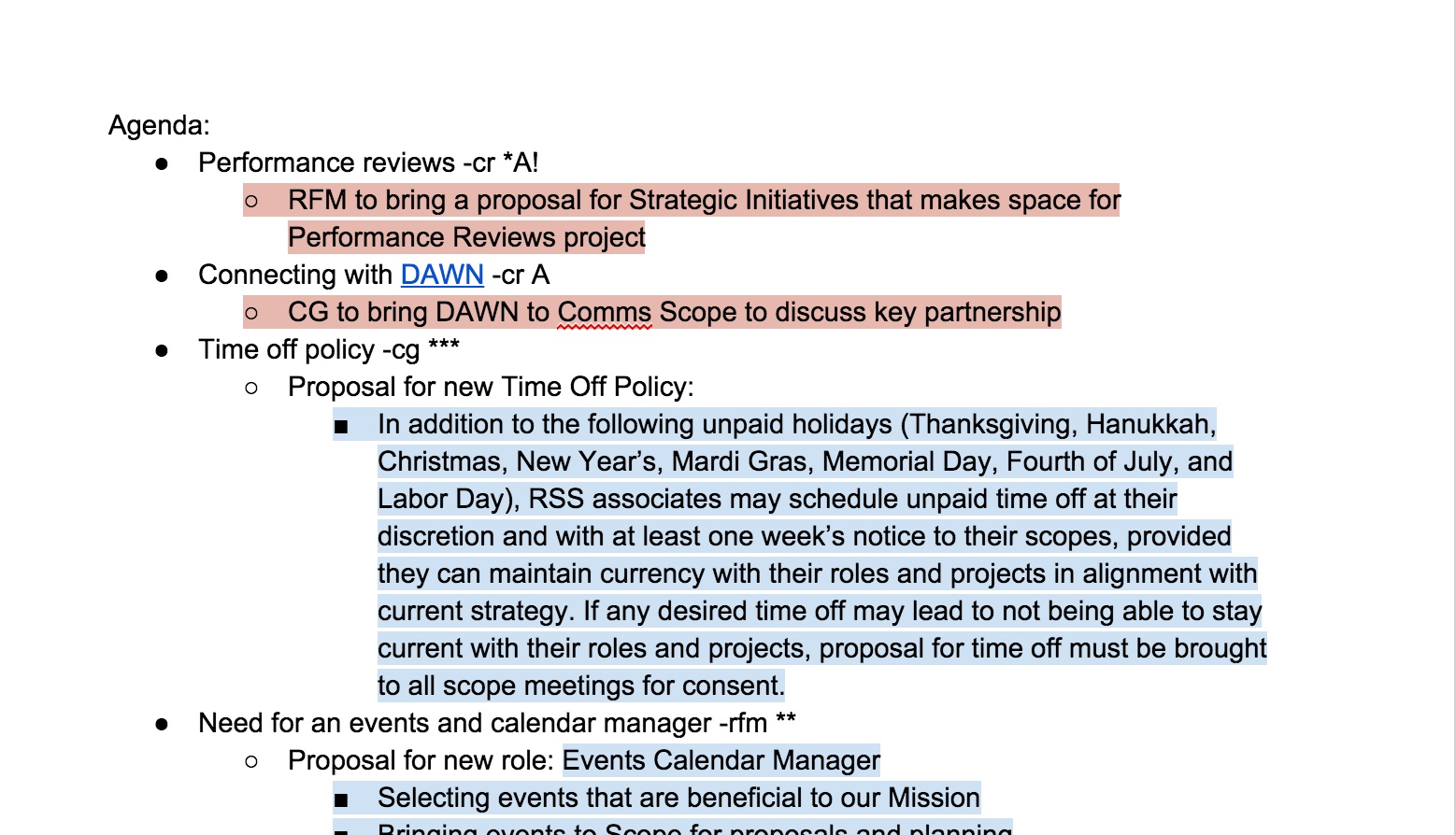 Hack #4: one tension-holder per tension
Hack #4: one tension-holder per tension
In order to introduce you to this hack, I need to share what we mean by ‘tension’ in this context. We use the term ‘tension’ to indicate any difference between where we are as a team today and where we could be. This could be a better idea for how we do something or an issue that’s getting in the way of good work being done. So the term is not just negative, it’s also fundamentally positive because we’re inviting all teammates to sense what’s in the way of their doing better work, and bring that to the meeting agenda.
We recommend building your meeting agenda from the tensions of everyone present, not just the manager or the lead. When you allocate agenda building to one or a few, the opportunity to harness the collective intelligence of your team is lost, even if you, as the agenda builder go around to ask people before the meeting what’s on their mind.
This subtle shift can be profound and can take a few weeks or months of practice to produce engagement, but it will do so. We recommend you build your meeting agenda from the tensions of all present and then invite team members to vote on those tensions according to which ones they feel are most important to this particular meeting.
In addition, as agenda items are placed on the agenda, have the person raising that tension put their initials on the item. This is critical because that person becomes the ‘tension-holder’ for that item which means they carry a special role during the processing of that agenda item to identify the outcomes which will incrementally move their tension forward. In other words, it’s not up to the manager or anyone else on the team to decide if the outcome has moved the tension-holder’s tension forward, that decision is made by the tension holder.
So for example, and to reference hack #3, when an agenda item requires a decision, the tension holder is responsible for crafting a proposal for the decision and making amendments to it prior to the objection round. This is a hugely streamlining and simplifying hack. If we don’t have a tension holder who has this kind of power in a team meeting, items will drag on for much longer than is necessary or helpful.
What’s Next?!
So, there’s the 4 hacks! It is so important to get a working flow for our collaborative meetings. There’s absolutely a reason why people hate meetings, so let’s not recreate those awful patterns in our collaborative meetings! If you missed Part 1, check it out here to get grounded in why we spend so much time thinking about meetings.
And, if you want to learn more about these hacks, check out Round Sky Solutions’ website and their online training that focuses on the tools and skills needed to hone in on being a grounded and powerful collaborative facilitator and leader.
Come learn more about this online collaborative management training and the community of practice we’re nurturing.
Enlivening Edge is an affiliate partner of Round Sky Solutions.
Republished with permission.
Featured image/graphic link added by Enlivening Edge Magazine.

